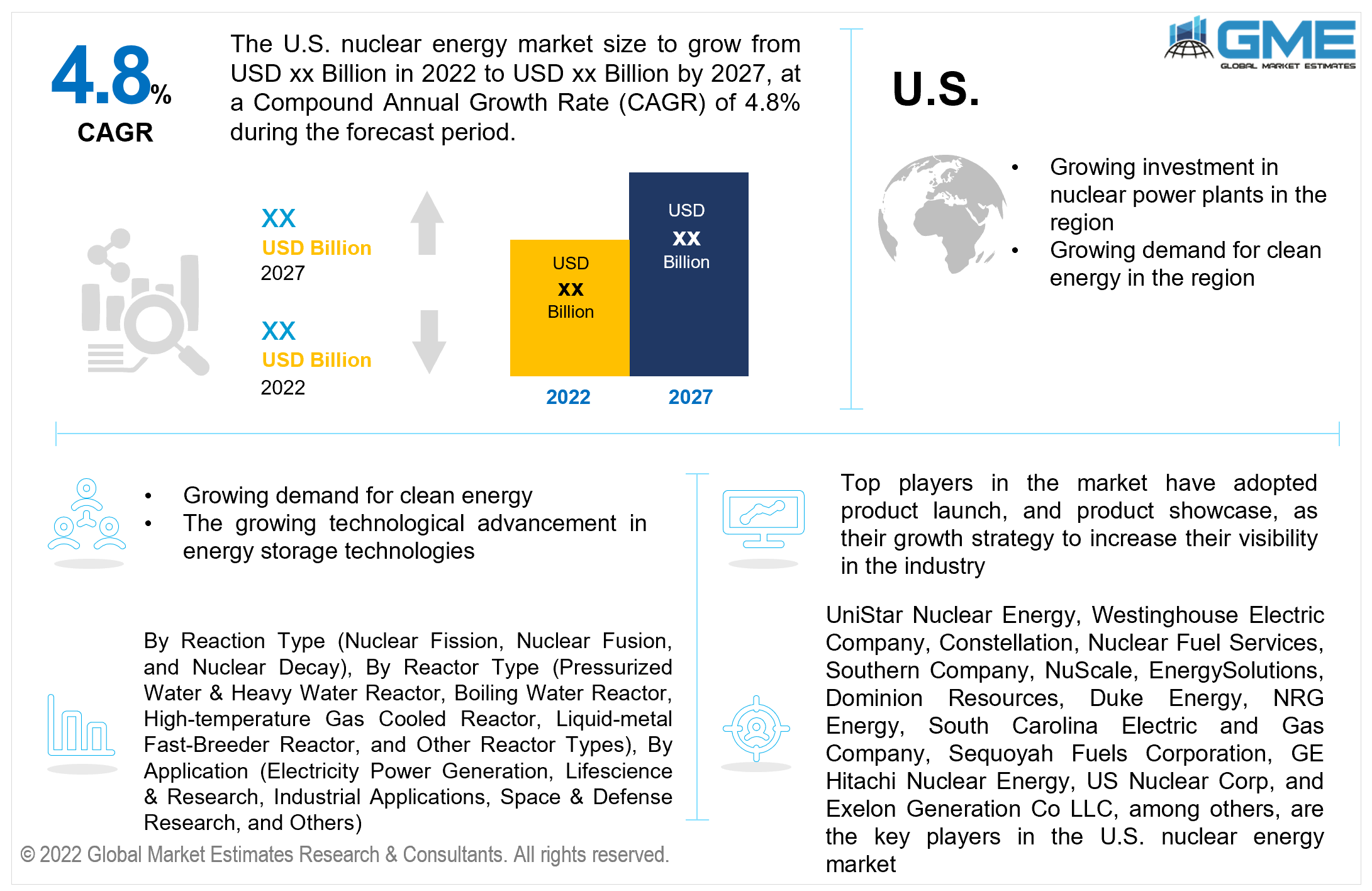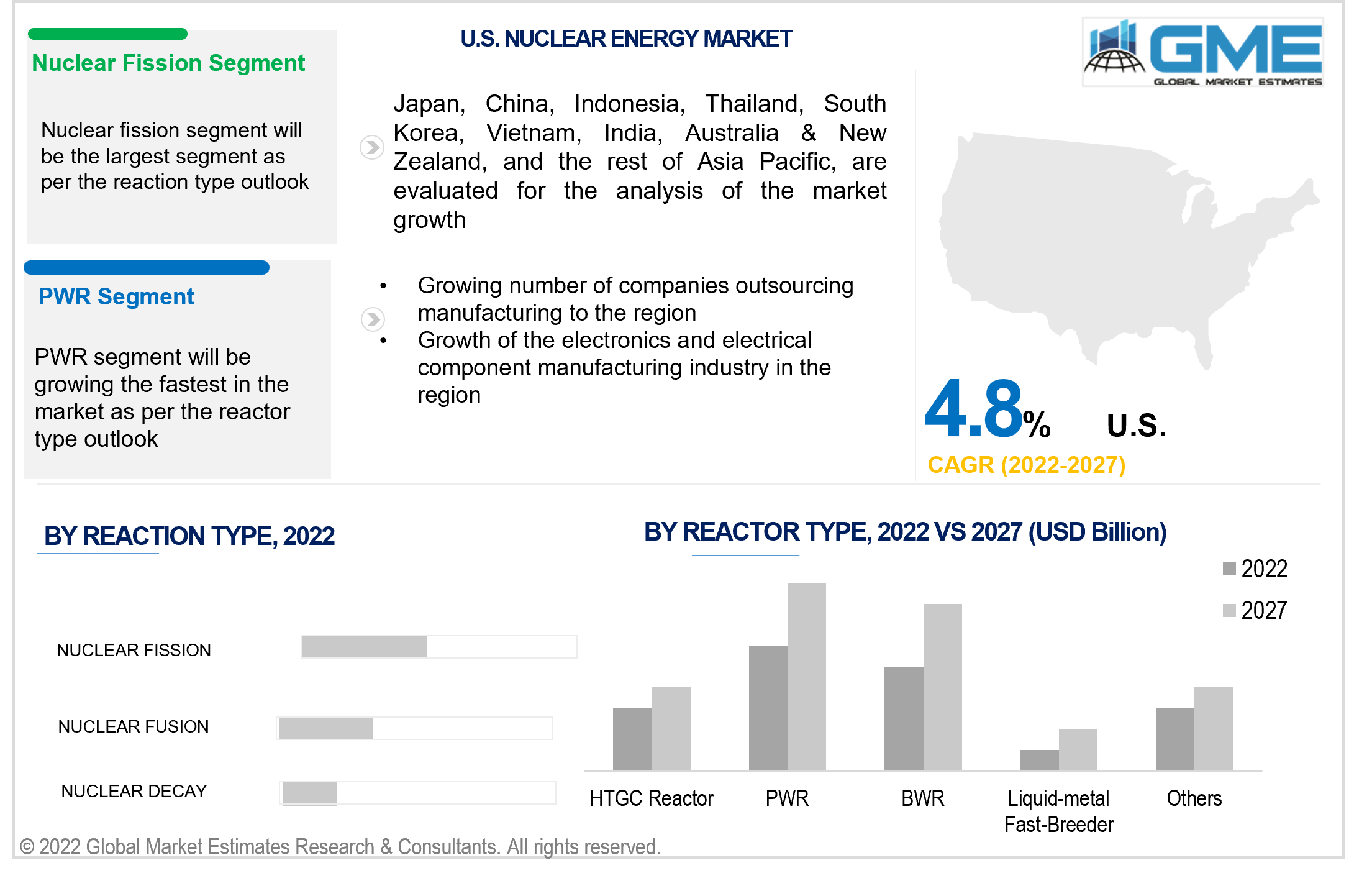
U.S. Nuclear Energy Market Size, Trends & Analysis - Forecasts to 2027 By Reaction Type (Nuclear Fission, Nuclear Fusion, and Nuclear Decay), By Reactor Type (Pressurized Water & Heavy Water Reactor, Boiling Water Reactor, High-temperature Gas Cooled Reactor, Liquid-metal Fast-Breeder Reactor, and Other Reactor Types), By Application (Electricity Power Generation, Lifescience & Research, Industrial Applications, Space & Defense Research, and Others), Company Market Share Analysis, and Competitor Analysis
The U.S. Nuclear Energy Market is projected to grow at a CAGR value of 4.8% from 2022 to 2027. The nuclear energy market in the United States is largely driven by the increasing pressure on the American government to reduce its carbon emissions and the increasing amount of electricity being generated from clean energy sources. The growing energy demand from the rising population and industrial manufacturing, strained supply sources, increasing water demand, need for protection against fuel price fluctuations, and need for energy self-sufficiency, among others were some of the major drivers of the U.S. nuclear energy market.
The United States began generating electricity through commercial nuclear power plants as early as 1958. Increased investment in research and development into nuclear energy technology has been one of the major drivers of the U.S. nuclear energy market. With over fifty nuclear power plants with over ninety nuclear reactors generating electricity has resulted in the United States becoming one of the largest nuclear energy generating countries in the world. The country accounts for over 30% of the world’s nuclear energy generation. The falling cost of nuclear power plant operations such as refueling, maintenance, and safety systems, among other costs is expected to increase the demand for nuclear energy in the United States. The renewal of existing power plants to meet growing energy demands of almost a 1% increase annually is expected to further increase the demand for nuclear energy in the United States.
Technological advancements such as small modular reactors, and light water reactors, among others, are expected to further enhance the demand for nuclear energy. The investment into the research and development of novel nuclear energy reactors and reactor technologies is expected to further enhance the growth of the market. The development of new energy storage technologies will allow for more efficient storage of energy. Increasing investment into the adoption of nuclear energy for space exploration, submarine engines, and other technologies is another factor for the growth of the market.
The U.S. nuclear energy market has been traditionally restrained by the falling price of gas-generated electricity. The growing investment in other clean and renewable energy sources such as wind and solar energy is restraining the growth of the nuclear energy market.
The COVID-19 pandemic has resulted in supply chain restrictions and resulted in various manufacturing and energy shortage issues across the globe. The dependence of countries for energy on nuclear power plants saw nuclear power plants maintain operations. Falling energy consumption owing to shutdowns did reduce the demand for nuclear energy during the pandemic. The market is expected to bounce back as companies return to full operations.
The nuclear energy market is largely driven by the need to reduce carbon emission from energy generation, growing energy demand, increased focus on improving energy self-sustainability, increased investment in nuclear energy technology, and growing technological advancements in the industry.

Based on the type of reaction, the nuclear energy market is segmented into nuclear fission, nuclear fusion, and nuclear decay. The nuclear fission segment is expected to hold the largest piece of the market during the forecast period. The ease of generating electricity through nuclear fission, more suited to current technology, and greater control over the process have resulted in the dominance of the nuclear fission segment. The nuclear fusion reaction is expected to showcase better growth rates during the forecast period owing to increased investment in R&D of nuclear fusion reactors and technological advancements.
Based on the type of reactor, the nuclear energy market is segmented into pressurized water & heavy water reactor, boiling water reactor, high-temperature gas-cooled reactor, liquid-metal fast-breeder reactor, and other reactor types. Pressurized water and heavy water segment is expected to hold the largest piece of the market during the forecast period. These reactors are increasingly stable, lower chance of contamination, have greater control over the reaction, and greater technology maturity have led to the dominance of the pressurized water and heavy water segment. Pressurized water reactors are the most common type of reactors employed in the United States.

Based on the applications, the nuclear energy market is segmented into electricity power generation, lifescience & research, industrial applications, space & defense research, and others. The electricity power generation segment is expected to hold the largest piece of the market during the forecast period. The growing energy demands and increased demand for clean energy have led to the dominance of the electricity power generation segment.
UniStar Nuclear Energy, Westinghouse Electric Company, Constellation, Nuclear Fuel Services, Southern Company, NuScale, EnergySolutions, Dominion Resources, Duke Energy, NRG Energy, South Carolina Electric and Gas Company, Sequoyah Fuels Corporation, GE Hitachi Nuclear Energy, US Nuclear Corp, and Exelon Generation Co LLC, among others, are the key players in the U.S Nuclear Energy market.
Please note: This is not an exhaustive list of companies profiled in the report.
Chapter 1 Methodology
1.1 Market Scope & Definitions
1.2 Estimates & Forecast Calculation
1.3 Historical Data Overview and Validation
1.4 Data Sources
1.4.1 Secondary
1.4.2 Primary
Chapter 2 Report Outlook
2.1 U.S Nuclear Energy Industry Overview, 2020-2026
2.1.1 Industry Overview
2.1.2 Reaction Type Overview
2.1.3 Reactor Type Overview
2.1.4 Application Overview
2.1.6 Regional Overview
Chapter 3 U.S Nuclear Energy Market Trends
3.1 Market Segmentation
3.2 Industry Background, 2020-2026
3.3 Market Key Trends
3.3.1 Positive Trends
3.3.1.1 Rising demand for clean energy
3.3.2 Industry Challenges
3.3.2.1 High cost of adoption
3.4 Prospective Growth Scenario
3.4.1 Reaction Type Growth Scenario
3.4.2 Reactor Type Growth Scenario
3.4.3 Application Growth Scenario
3.5 COVID-19 Influence over Industry Growth
3.6 Porter’s Analysis
3.7 PESTEL Analysis
3.8 Value Chain & Supply Chain Analysis
3.9 Regulatory Framework
3.9.1 North America
3.9.2 Europe
3.9.3 APAC
3.9.4 LATAM
3.9.5 MEA
3.10 Application Overview
3.11 Market Share Analysis, 2020
3.11.1 Company Positioning Overview, 2020
Chapter 4 U.S Nuclear Energy Market, By Reaction Type
4.1 Reaction Type Outlook
4.2 Nuclear Fission
4.2.1 Market Size, By Region, 2020-2026 (USD Billion)
4.3 Nuclear Fusion
4.3.1 Market Size, By Region, 2020-2026 (USD Billion)
4.3 Nuclear Decay
4.3.1 Market Size, By Region, 2020-2026 (USD Billion)
Chapter 5 U.S Nuclear Energy Market, By Reactor Type
5.1 Reactor Type Outlook
5.2 Pressurized Water & Heavy Water Reactor
5.2.1 Market Size, By Region, 2020-2026 (USD Billion)
5.3 Boiling Water Reactor
5.3.1 Market Size, By Region, 2020-2026 (USD Billion)
5.4 High-temperature Gas Cooled Reactor
5.4.1 Market Size, By Region, 2020-2026 (USD Billion)
5.5 Liquid-metal Fast-Breeder Reactor
5.5.1 Market Size, By Region, 2020-2026 (USD Billion)
5.6 Other Reactor Types
5.6.1 Market Size, By Region, 2020-2026 (USD Billion)
Chapter 6 U.S Nuclear Energy Market, By Application
6.1 Electricity Power Generation
6.1.1 Market Size, By Region, 2020-2026 (USD Billion)
6.2 Lifescience & Research
6.2.1 Market Size, By Region, 2020-2026 (USD Billion)
6.3 Industrial Applications
6.3.1 Market Size, By Region, 2020-2026 (USD Billion)
6.4 Space & Defense Research
6.4.1 Market Size, By Region, 2020-2026 (USD Billion)
6.5 Others
6.5.1 Market Size, By Region, 2020-2026 (USD Billion)
Chapter 7 Company Landscape
7.1 Competitive Analysis, 2020
7.2 UniStar Nuclear Energy
7.2.1 Company Overview
7.2.2 Financial Analysis
7.2.3 Strategic Positioning
7.2.4 Info Graphic Analysis
7.3 Westinghouse Electric Company
7.3.1 Company Overview
7.3.2 Financial Analysis
7.3.3 Strategic Positioning
7.3.4 Info Graphic Analysis
7.4 Constellation
7.4.1 Company Overview
7.4.2 Financial Analysis
7.4.3 Strategic Positioning
7.4.4 Info Graphic Analysis
7.5 Nuclear Fuel Services
7.5.1 Company Overview
7.5.2 Financial Analysis
7.5.3 Strategic Positioning
7.5.4 Info Graphic Analysis
7.6 Southern Company
7.6.1 Company Overview
7.6.2 Financial Analysis
7.6.3 Strategic Positioning
7.6.4 Info Graphic Analysis
7.7 NuScale
7.7.1 Company Overview
7.7.2 Financial Analysis
7.7.3 Strategic Positioning
7.7.4 Info Graphic Analysis
7.7 EnergySolutions
7.7.1 Company Overview
7.7.2 Financial Analysis
7.7.3 Strategic Positioning
7.7.4 Info Graphic Analysis
7.9 Dominion Resources
7.7.1 Company Overview
7.7.2 Financial Analysis
7.7.3 Strategic Positioning
7.7.4 Info Graphic Analysis
7.10 Duke Energy
7.10.1 Company Overview
7.10.2 Financial Analysis
7.10.3 Strategic Positioning
7.10.4 Info Graphic Analysis
7.11 Other Companies
7.11.1 Company Overview
7.11.2 Financial Analysis
7.11.3 Strategic Positioning
7.11.4 Info Graphic Analysis
The Global U.S. Nuclear Energy Market has been studied from the year 2019 till 2027. However, the CAGR provided in the report is from the year 2022 to 2027. The research methodology involved three stages: Desk research, Primary research, and Analysis & Output from the entire research process.

The desk research involved a robust background study which meant referring to paid and unpaid databases to understand the market dynamics; mapping contracts from press releases; identifying the key players in the market, studying their product portfolio, competition level, annual reports/SEC filings & investor presentations; and learning the demand and supply-side analysis for the U.S. Nuclear Energy Market.

The primary research activity included telephonic conversations with more than 50 tier 1 industry consultants, distributors, and end-use product manufacturers.

Finally, based on the above thorough research process, an in-depth analysis was carried out considering the following aspects: market attractiveness, current & future market trends, market share analysis, SWOT analysis of the company and customer analytics.

Frequently Asked Questions
Tailor made solutions just for you
80% of our clients seek made-to-order reports. How do you want us to tailor yours?
OUR CLIENTS